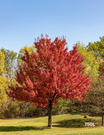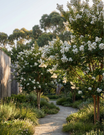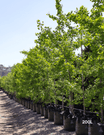Proper fertilization is key to nurturing garden trees, promoting vibrant growth and long-lasting health. Trees, especially in high-end gardens, require specific nutrients to thrive and reach their full potential. Even the most beautiful species may struggle with stunted growth, poor color, or disease susceptibility without adequate nourishment. By fertilizing correctly, you’re enhancing the beauty of your trees and ensuring they remain strong and resilient for years to come.
In this guide, we’ll explore the importance of fertilization for your trees, focusing on renowned species such as Crepe Myrtle (Lagerstroemia indica), Magnolia Little Gem (Magnolia grandiflora ‘Little Gem’), and Weeping Lilly Pilly (Waterhousia floribunda). We’ll cover everything from the best fertilization schedules to the types of fertilizers that work best for each tree and how to apply them effectively. Whether you’re enhancing a small feature garden or nurturing large privacy trees, this guide will ensure you’re equipped with the knowledge to give your trees the care they deserve.
Why Fertilization is Key to Tree Growth
Fertilization is vital in supplementing the essential nutrients that trees need to grow vigorously, particularly in soils that may be lacking. In many modern gardens, especially in urban or suburban settings, the soil often lacks the vital nutrients trees need to reach their full potential. Regular fertilization helps bridge this gap by providing the right balance of nutrients such as nitrogen, phosphorus, and potassium, crucial for healthy growth, strong root systems, and disease resistance.
Without these nutrients, trees can exhibit weak growth, poor foliage, and a reduced ability to withstand environmental stressors. Fertilization ensures that your trees survive and thrive, showing off their best qualities. Whether it's the stunning flowers of the Crepe Myrtle (Lagerstroemia indica), the glossy evergreen foliage of the Magnolia Little Gem (Magnolia grandiflora ‘Little Gem’), or the dense privacy provided by the Weeping Lilly Pilly (Waterhousia floribunda), the right fertilizer will help these trees perform at their best year after year.
Fertilization Schedule
Timing is everything when it comes to fertilization. Knowing when to fertilize your trees can significantly affect their health and growth. Fertilizing at the wrong time can lead to wasted effort or, worse, damage to your trees while fertilizing at the right time maximizes the benefits.
For example, the Crepe Myrtle (Lagerstroemia indica), known for its breathtaking summer blooms, responds best when fertilized in early spring as its buds develop. The Magnolia Little Gem (Magnolia grandiflora ‘Little Gem’) and Weeping Lilly Pilly (Waterhousia floribunda) also benefit from a well-planned schedule that encourages healthy growth throughout the year. Here's a recommended schedule:
- Spring: The optimal time to begin fertilization is early spring, just as your trees emerge from their winter dormancy. A balanced, slow-release fertilizer will ensure they receive steady nutrients as they grow.
- Summer: Mid-summer, especially for species like the Crepe Myrtle, can be a great time to give your trees a nutrient boost, especially if they're flowering. This additional application will help prolong blooming and enhance the richness of the flowers.
- Autumn: As the growing season winds down, apply a final round of fertilizer in late autumn. This helps trees like the Magnolia Little Gem and Weeping Lilly Pilly store essential nutrients for the winter months and prepares them for a strong start in the spring.
Choosing the Right Fertilizer for Your Trees
The type of fertilizer you choose for your trees is just as important as the schedule. Different trees have varying nutrient requirements, and providing the right balance of essential elements will ensure they flourish.
Types of Fertilizers:
- Granular Slow-Release Fertilizers: These are ideal for long-term feeding. They slowly release nutrients into the soil, offering a steady supply lasting for months. Trees like the Weeping Lilly Pilly (Waterhousia floribunda) benefit greatly from these, requiring consistent nutrient support to maintain their dense foliage.
- Liquid Fertilizers: These fast-acting fertilizers deliver quick nutrients, especially for trees needing immediate attention. For Crepe Myrtle (Lagerstroemia indica), a liquid fertilizer in the middle of the blooming season can enhance flower production and leaf color.
- Organic Fertilizers: If you're conscious of your garden’s environmental impact, organic fertilizers are an excellent choice. Compost, manure, and other natural options provide nutrients and improve the soil structure. For trees like Magnolia Little Gem (Magnolia grandiflora ‘Little Gem’), which prefers nutrient-rich soil, organic fertilizers can be particularly beneficial.
How to Apply Fertilizer Effectively
Knowing how to apply fertilizer properly ensures that trees absorb the maximum nutrients. Here are the steps to follow for the most effective fertilization:
- Measure the Drip Line: Start by determining the drip line, which is the outer edge of the tree’s canopy. This is where the tree’s feeder roots are most concentrated, and it’s the best area to apply fertilizer.
- Spread Evenly: Apply the fertilizer evenly around the drip line, avoiding the trunk. Concentrating fertilizer too close to the tree's base can lead to root burn, damaging the tree rather than helping it.
- Water Generously: After applying the fertilizer, water the area thoroughly. This helps the nutrients dissolve and penetrate deep into the soil, where the tree’s roots can absorb them.
- Monitor and Reapply: Depending on the fertilizer used, you may need to reapply it throughout the growing season. Be mindful of how your trees respond and adjust the schedule if required.
Fertilizing Specific Trees
Crepe Myrtle (Lagerstroemia indica)
The Crepe Myrtle is famous for its stunning, long-lasting summer blooms. Its beauty and hardiness make it a favorite in many upscale gardens, where it can serve as a focal point or provide privacy.
Key Facts:
- Mature Height: 3-6 meters
- Mature Width: 4-6 meters
- Best Uses: Feature tree, screening tree, or avenue planting
- Leaf Appearance: Glossy green leaves turning bright red or orange in autumn
- Rate of Growth: Medium to fast
- Tolerates: Heat, drought, and poor soils
Fertilization Tips:
- Fertilize in early spring with a balanced slow-release fertilizer to encourage healthy growth.
- For vibrant blooms, consider adding a high-phosphorus fertilizer in mid-summer.
- Avoid fertilizing late in the season, as this can cause new growth to be damaged by frost.
Magnolia Little Gem (Magnolia grandiflora ‘Little Gem’)
The Magnolia Little Gem is admired for its compact form and beautiful white flowers. It’s a perfect tree for smaller, more intimate gardens, where its glossy leaves and fragrant blooms add a touch of luxury.
Key Facts:
- Mature Height: 4-6 meters
- Mature Width: 2-3 meters
- Best Uses: Screening tree, feature tree, or as a container tree
- Leaf Appearance: Glossy green with a velvety brown underside
- Rate of Growth: Moderate
- Tolerates: Poor soil, urban pollution
Fertilization Tips:
- Use an acidic, slow-release fertilizer in early spring to support growth.
- Be cautious not to over-fertilize, which can cause weak, leggy growth.
- Mulch regularly to retain moisture and provide additional nutrients.
Weeping Lilly Pilly (Waterhousia floribunda)
The Weeping Lilly Pilly is a fast-growing tree known for its elegant, weeping foliage. It’s ideal for creating lush, dense screens or hedges in a luxurious garden setting.
Key Facts:
- Mature Height: 8-10 meters
- Mature Width: 4-6 meters
- Best Uses: Screening tree, hedge, or feature tree
- Leaf Appearance: Glossy green leaves with bronze or pink new growth
- Rate of Growth: Fast
- Tolerates: Wet soils, drought once established
Fertilization Tips:
- Use a balanced slow-release fertilizer in spring for consistent growth.
- Supplement with a nitrogen-rich fertilizer in late spring for lush, dense foliage.
- Water thoroughly after each application to help nutrients penetrate the soil.
FAQs
How often should I fertilize my trees?
Most trees fertilize once in early spring and again in late autumn. For flowering species like Crepe Myrtle, a mid-summer application can boost blooms.
Can I use the same fertilizer for all trees?
While general-purpose fertilizers are effective, some trees, like Magnolia Little Gem, benefit from an acidic fertilizer. Tailoring the fertilizer to your tree’s needs ensures optimal growth.
What’s the best fertilizer for trees in pots?
Slow-release fertilizers work best for potted trees like Magnolia Little Gem. They provide nutrients over time without overwhelming the limited soil volume.
Conclusion
Fertilization is an essential practice that ensures your trees thrive, showcasing their full beauty and strength. Whether it’s the vibrant blooms of the Crepe Myrtle, the evergreen foliage of Magnolia Little Gem, or the lush privacy provided by the Weeping Lilly Pilly, the right fertilizer will help your trees flourish. With proper timing, careful fertilizer selection, and effective application techniques, your trees will continue to thrive, adding elegance and vibrancy to your garden for years to come.




















































1 comment
Janice Reichelt
I have an Agonis After Dark when should I fertiliser it and with which fertiliser would be best, it’s looking a little sad at the moment.
Thank you for any suggestions, Joseph x
Leave a comment
This site is protected by hCaptcha and the hCaptcha Privacy Policy and Terms of Service apply.